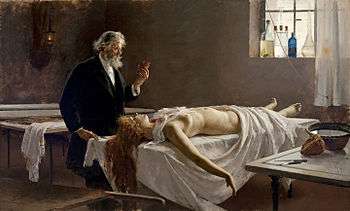Museo de Málaga
The Museo de Málaga is a museum in Málaga, Andalusia, Spain. Formed in 1973, it brought together the former Museo Provincial de Bellas Artes (Provincial Museum of Fine Arts), born in 1913, and Museo Arqueológico Provincial (Provincial Archeological Museum), born in 1947. As of 2010, the museum remains institutionally divided into two "sections" corresponding to the older museums.[1] There are slightly over 2,000 pieces in the Fine Arts collection and over 15,000 in the Archeology collection.[2]
Fine Arts section

The Fine Arts section has its origin in the Royal Decree of 24 July 1913 that encouraged the Ministry of Public Instruction to establish provincial fine arts museums in those provincial capitals that did not yet have such an institution. Málaga's Real Academia de Bellas Artes de San Telmo ("San Telmo Royal Academy of Fine Arts") had long wished to create such and institution. The Museo Provincial de Bellas Artes was founded 3 February 1915 and opened its doors in a temporary location in the Calle Pedro de Toledo 17 August 1916.[1] In 1920 it moved to the former Jesuit college of San Sebastián, which also housed the Academy and a school of fine arts.[1][3] It moved to the Buenavista Palace in 1961, but had to leave that facility in 1997 when the Andalusian Autonomous Government bought the palace to convert it into the Museo Picasso Málaga. At that time the Fine Arts section moved to the Palacio de la Aduana, where temporary exhibitions have been held.[1]
The museum includes works by Luis de Morales, Luca Giordano, Bartolomé Esteban Murillo, Antonio del Castillo, Alonso Cano, Pedro de Mena, Jusepe de Ribera, Francisco Zurbarán, Diego Velázquez, Francisco de Goya, Federico de Madrazo, Ramón Casas, José Moreno Carbonero, Enrique Simonet, Joaquín Sorolla, Léon Bonnat, Franz Marc and Pablo Picasso.[4][5]
Archeological section

The Archeological section has its origin in a Decree of 1947, integrating the collections of the old Museo Loringiano (based in the 19th century collection of the Marquesses of Casa-Loring) and the archeological holdings of the Museo Provincial de Bellas Artes. The latter came from digs that had occurred in the province since the 1930s, including digs in the Alcazaba of Málaga, where the new museum opened in 1949. In 1996, rehabilitation of the Alcazaba required a move. The collection was temporarily housed at the 16th century Convento de la Trinidad until 1999, when it moved to the former provincial historical archive in the Avenida de Europa, which it shares with the Biblioteca Pública del Estado ("State Public Library"). As of 2010 it is not open to the public, although there have been a series of temporary exhibitions at the Palacio de la Aduana.[1]
Notes
- 1 2 3 4 5 Museo de Málaga: Historia, Museo de Málaga. Accessed online 2010-01-19.
- ↑ Rafael Puertas Tricas, El Uso Museístico del Palacio de la Aduana, Revista Jábega (Centro de Ediciones de la Diputación de Málaga), Number 92, 2002, 5:13. p. 8–9 (p. 4–5 of PDF). Accessed online 2010-01-19.
- ↑ Sede, Ateneo de Málaga. Accessed online 2010-01-17
- ↑ An older, French-language guide to Málaga reproduced at http://espagnetourisme.com/malaga.html (accessed online 2010-01-17) lists works by de Morales, Luca Giordano, Murillo, Antonio dei Castillo, Alonso Cano, de Ribera, Zurbarán, José Moreno Carbonero, Simonet, and the altarpiece attributed to Pedro de Mena, and the early Picassos.
- ↑ Monumentos de Málaga, webmalaga.com, accessed online 2010-01-17, lists Murillo, Zurbarán, Morales, Alonso Cano, Ribera, Luca Giordano, Sorolla, Martínez Cubells, Picasso, and singles out the collection of 19th-century painters, mentioning in particular Muñoz Degrain, Simonet, and Nogales (presumably Avelino Nogales).
See also
External links
| Wikimedia Commons has media related to Museo de Málaga. |
- Museo de Málaga, official English-language site.
Coordinates: 36°43′12″N 4°25′03″W / 36.720087°N 4.417401°W
